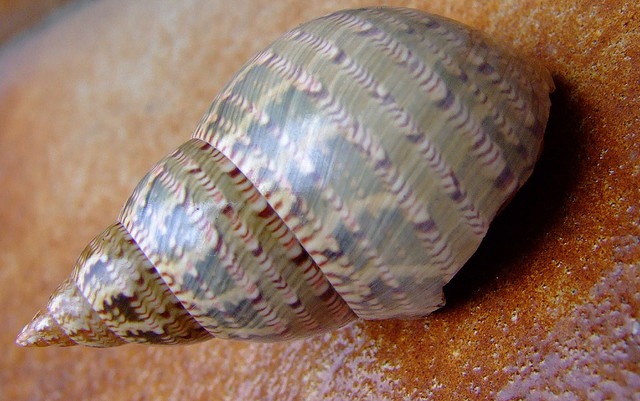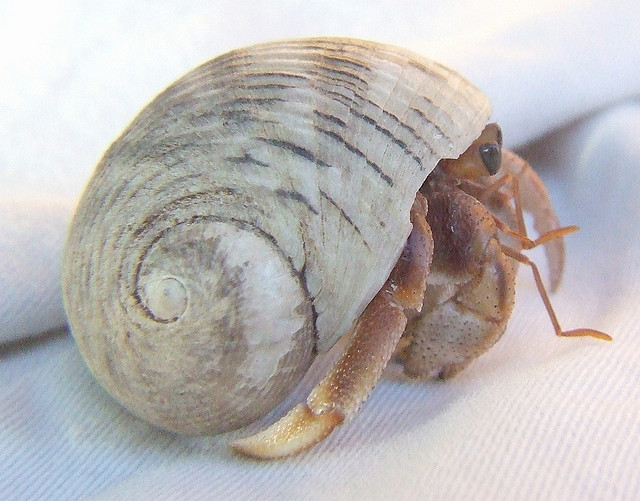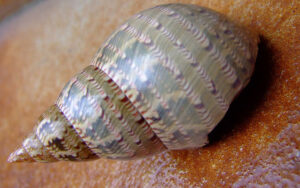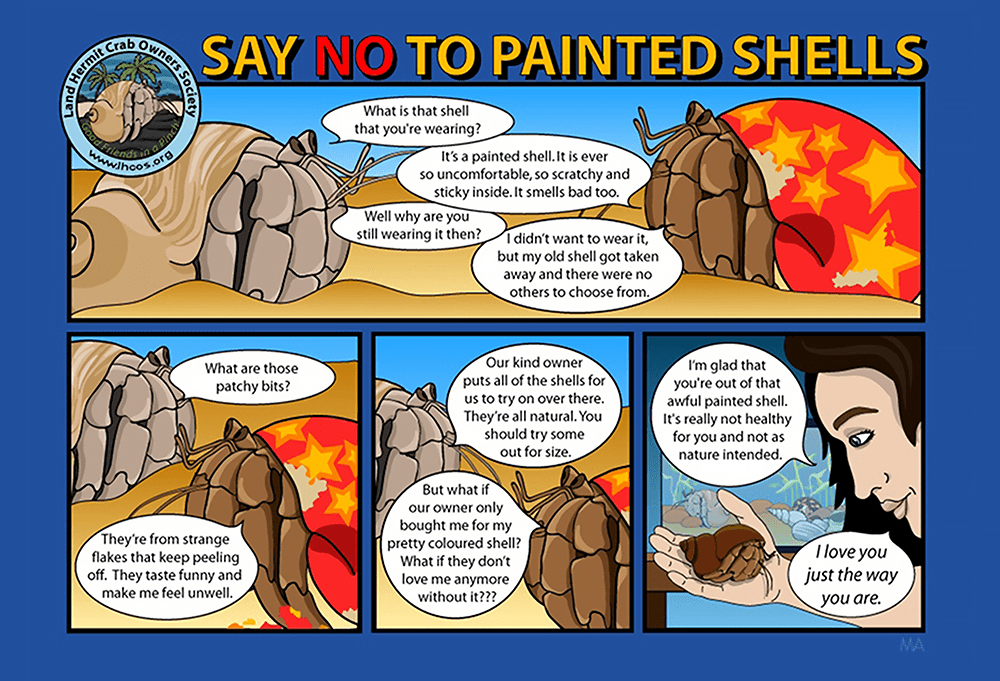One Size Does Not Fit All
For each crab I have a few shells which are just a little bit bigger than their existing shell. When the crab moults (approximately once a year) they need a choice of shells to move into. The change in body size may be small but it will be important that your growing crab needs a choice of shells. They will be very crabby if they do not have bigger shells for bigger bodies.
Upsizing Before A Moult
Sometimes hermit crabs will change into a bigger shell just before they moult. Often these hermit crabs have spent a long time in the salt water pond and their abdomens have swelled just as our feet do when on long car or bus/coach journeys. You may have felt your feet feel swollen and cramped within your shoes. That must be how your hermit crab must feel when they have drank a lot of water from the fresh water dish or their salt pond. They need to go through this process so that they can burst their exo, then slip free. I guess it is a little bit like when you are young and your feet grow so fast that you often have them split or come apart at the seams.

What To Look For When Selecting Suitable Seashells
When selecting shells, it is important to find seashells that are suitable for your hermit crabs. The rule of thumb is to have three shells per hermit crab, including:
– one the same size as the one your hermit crab is currently in, both in aperture (opening) and perhaps in width/length. It may be the same shell species/type or one of the more popular seashells so that you maximise the chance your hermit crab will be happy in their new shell
– one slightly smaller than the one your hermit crab is currently in, especially if the shell they are wearing is sliding and they have poor control of it, OR they are obviously tiny within a large shell
– one slightly bigger than the one your hermit crab is in, in case they need more room pre/post moult or their own shell is too small for them.
You look for any holes or cracks that could cause the hermit crab to dehydrate from drained shell water. Hermit crabs use not only to keep their gills moist so that they can breathe, but also to regulate the salts within their shells. You may observe your hermit crabs as they examine each shell with great care, picking it up, turning it over, looking for any reason not to chose it as their new mobile home. It is important that if there are holes in the shell, especially in the whirl where the shell water is kept, that you quickly find some suitable replacement shells.
Differences in Seashell Selection By Species
Aussie Hermit Crabs and Ecuadorian/Pacific Crabs are very similar in appearance and seashell selection. Thais or Rock/Purple shells are found in Australia and parts of the Pacific, as well as other areas. They are available to Aussie Hermit Crabs and Ecuadorian land hermit crabs and are often harvested from the wild wearing the rather plain-looking shells with an interior that is quite smooth and pearly of nacre. There are many types of Thais shells, and they are linked to Murex shells, which are another favourite shell of many land hermit crabs. For information on other land hermit crabs view this video by Stacy of The Crab Street Journal
The Perfect Fit
It is important to measure the cheliped of the hermit crab and match it up with some shells that will offer a source of protection. If the hermit crab can curl up within the shell, using the cheliped/grasping claw as a little door such as in the image above, then they will have a fighting chance against aggressive shell-fight bullies.
Keep Your Hermit From Becoming Crabby – Avoiding Shell Fights
Often if there is a dearth of suitable shells, hermit crabs will rap against the shells of their tank mates, or attempt to drag them out of the shell by the cheliped(claw) or peripods(walking legs). As you can see, the barracade above would make it very hard for the aggressor to pull this hermit crab from its prized Tapestry Turban (Turbo petholatus) shell home.
You may find that despite the presence of many suitable shells, there will be some hermit crabs that just refuse to budge from their old and battered natural or pre-worn shells. This can be quite frustrating to owners who do try to provide new shells for them to change into, however there are many reasons for this reluctance to move on. Often, hermit crabs will prefer a pre-worn shell that has been modified by many hermit crabs over the years and is as snug as an old woolen jumper that while looks a bit daggy, is quite cumfy and practical. They might prefer the weight or opening type of the shell they are inhabiting to those offered, so will wait until a more ideal shell comes along.
A Preference For A Certain Type or Fit
I have found that hermit crabs will often change into seashells much like those they are in, if they like the particular ‘fit’ for their abdomen. Just like we have preferences for the type of shoes we wear, hermit crabs like a shell that fits ‘just right’. You might see hermit crabs whip their abdomens in and out of shells while they make up their mind, OR wait around until one of their tank mates moves out of a prized shell, and then there is a seashell vacancy chain (domino effect) whereby you may watch crab B slip into the discarded A, Crab C move into the roomer discarded shell of crab B, and so on.
It is important that if you have a hermit crab that desperately needs to change their shells, that when you finally find a shell perfect for their needs, that you keep the other hermit crabs from pinching their shells. Perhaps just after a bath you could create a little playpen out of a clean ice cream tub and place some clean, suitable shells with the hermit crab so that they have the opportunity to change without having the misfortune of finding the shell isn’t such a good fit but stuck in it because their ‘old faithful’ shell was lost to them.
Seashell Modification
“Hermit crabs are a primary cause of wear to gastropod shells. Many top-shells had crab-modifed apertures. Also, interior wear patterns that corresponded to outer breakage areas were observed in both crab-inhabited and abandoned top-shells. Vermeij (1987:243) states that hermit crabs of the genus Coenobita actually resorb the inner walls of the shells they inhabit, enlarging the inner chamber. Desirable shells are used by many generations of crabs, being outgrown, discarded, and reoccupied by other crabs.”1
If you have hermit crabs such as Ecuadorians then perhaps you just need to offer seashells similar to those they found in the wild, or those seashells proven to be a hit, such as Thais hamastoma which is growing in popularity and is also known as the Mexican Rock Shell.”1
Think Like A Crab
Think of how awful it would be if you found a pair of shoes on a beach and went to try them on, but someone stole your shoes, and you found that the shoes cramped your toes. You’d have to walk home in shoes that were ill suited and wait until the next good shell came along. If there were no spare shells available, you may find that a desperate crab could take matters into their own hands and simply fight to win ownership of the shell of another, in order to survive. If you see shell fights, it is imperitive that you re-assess your shell selections and isolate the aggressive crab or it may lead to fatalities.
Shell Types
Nerite Shells


Babylonia shells


Fox Shells

Pheasant Shells

Turbo shells

Say No To Painted Shells

A video by CNN on how land hermit crabs are forced into painted shells
Video by The Crab Street Journal
Footnotes:1. SCUDDER, S.J. AND QUITMYER, I.R(1998) Caribbean Journal of Science, Vol. 34, No. 1-2, 41-49, 1998 Copyright 1998 College of Arts and Sciences University of Puerto Rico, Mayag.ez Evaluation of Evidence for Pre-Columbian Human Occupation at Great Cave, Cayman Brac, Cayman Islands SYLVIA J. SCUDDER AND IRVY R. QUITMYER Department of Anthropology, Florida Museum of Natural History, University of Florida, Gainesville, Florida 32611








